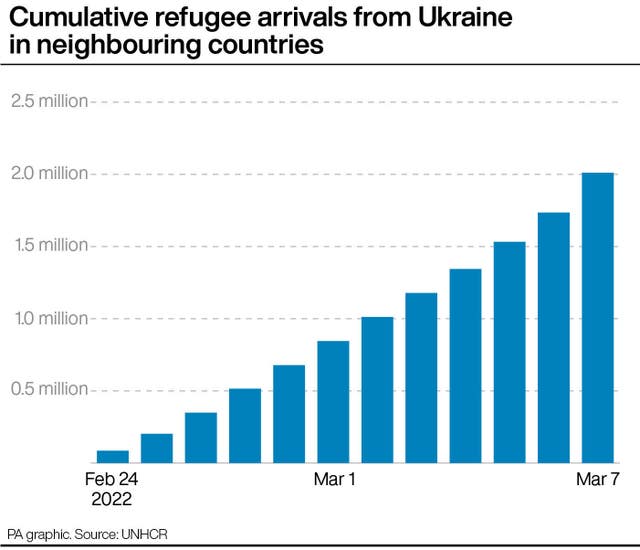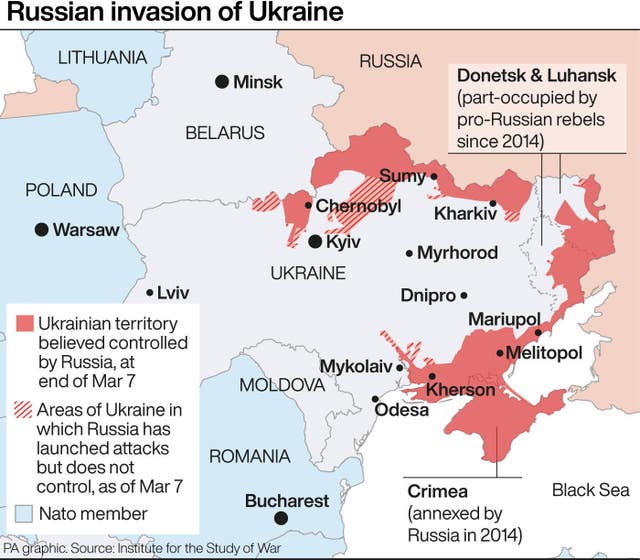
Richard Spurr 1am - 4am
8 March 2022, 14:04

UN officials said two million people have now fled Ukraine in Europe’s worst refugee crisis since the Second World War.
Buses have carried civilians out of one embattled Ukrainian city and supplies towards another, as officials tried to move people away from a Russian onslaught and ease a dire humanitarian situation for those still stuck.
But reports of renewed Russian attacks in one area threatened to again derail those efforts on the 13th day of the invasion.
UN officials said two million people have now fled Ukraine in Europe’s worst refugee crisis since the Second World War.

Demands for ways to safely evacuate civilians have surged along with intensifying shelling by Russian forces, who have made significant advances in southern Ukraine but stalled in some other regions.
Efforts to put in place ceasefires along humanitarian corridors have repeatedly failed amid Russian shelling.
Since the invasion began, more than 400 civilian deaths have been recorded by the UN human rights office, which said the true number is much higher. Ukrainian defence minister Oleksiy Reznikov said Russian military actions have killed 38 children and wounded more than 70.
In addition to the unfolding humanitarian disaster, the fighting has sent energy prices surging worldwide and stocks plummeting, and threatened the food supply and livelihoods of people around the globe who rely on crops farmed in the Black Sea region.

Western countries have condemned the invasion and sought to support Ukraine with weapons — and punish Vladimir Putin’s Russia with sanctions.
The measures have dealt a blow to the Russian economy, as companies pull out of or sharply curtail their business there. In a further sign of the country’s economic isolation, Shell announced on Tuesday it would stop buying Russian oil and natural gas.
On Tuesday, a convoy of buses packed with people moved along a snowy road from the north-eastern city of Sumy, according to video from the Ukrainian communications agency.
Deputy prime minister Iryna Vereshchuk said they were heading south west to the city of Poltava, and included students from India and China.

Buses emblazoned with red cross symbols carrying water, basic food staples and medicines moved towards the besieged southern port of Mariupol, to ferry civilians out of the city, but the Ukrainian president’s office later said it had been informed of shelling on the escape route.
It is unclear whether the supply convoy made it to Mariupol or whether civilians will freely board the buses if the shelling continues.
The deputy mayor also cast doubt on the evacuations, telling the BBC that Russian forces continued to bombard area where people were trying to gather. He said some roads were blocked and others were mined.
“This morning the situation did not change,” Sergei Orlov told the BBC. “So we still have… a city in blockade.”
The situation was growing more untenable in the city, which is without water, heat, sanitary systems or phones. Russia on Monday destroyed the natural gas supply.
The battle for Mariupol is crucial because its capture could allow Moscow to establish a land corridor to Crimea, which Russia seized from Ukraine in 2014. An estimated 200,000 people — nearly half the population of 430,000 — hope to flee.
Oleksiy Kuleba, governor of the Kyiv region, said Ukraine was also making arrangements to get people out of the suburb of Irpin, although it was not clear if that would be along one of the five official corridors the Russians promised.
There were few signs those routes were being used, apart from the evacuation from Sumy.

Ukrainian officials had pushed back on the proposals as several of the routes would funnel people into Russia or its ally Belarus, which was served as a launch pad for the invasion. They have called instead for corridors allowing people to head to western parts of Ukraine not under attack.
“Ukraine has not given permission for evacuation to Russia, we did not agree on those routes. The corridors to Russia have not been agreed upon with the Red Cross either,” said Ms Vereschchuk.
President Volodymyr Zelensky called for the expansion of humanitarian corridors, and more support from the Red Cross.
In a video address from an undisclosed location, he said a child had died of dehydration in Mariupol, in a sign of how desperate the city’s population has become.

He said there was no firm agreement on the route out of Mariupol, so “Russian troops can simply shoot on this transport on the way”.
Mr Zelensky accused the International Red Cross of “forbidding the use of its emblem on our cars”, but did not give details. Videos of buses heading out of Sumy and towards Mariupol have had signs with a red cross on the side but it is not clear who pasted them there.
The president again pleaded for air support from western countries. A senior US official said multiple countries were discussing whether to provide warplanes to Ukraine.
Ukraine’s general staff of the armed forces said in a statement that Ukrainian troops are continuing defence operations in the suburbs of Mariupol.
The general staff said “demoralisd” Russian forces are looting in places they have occupied, commandeering civilian buildings like farm hangars for military equipment, and are setting up firing positions in populated areas.
Ukrainian defence forces were also involved in operations in Chernihiv and the outskirts of Kyiv, the general staff said.
In Kyiv, soldiers and volunteers have built hundreds of checkpoints to protect the city of nearly four million, often using sandbags, stacked tyres and spiked cables.
Some barricades looked significant, with heavy concrete slabs and sandbags piled more than two storeys high, while others appeared more haphazard, with hundreds of books used to weigh down stacks of tyres.
“Every house, every street, every checkpoint, we will fight to the death if necessary,” said Kyiv mayor Vitali Klitschko.